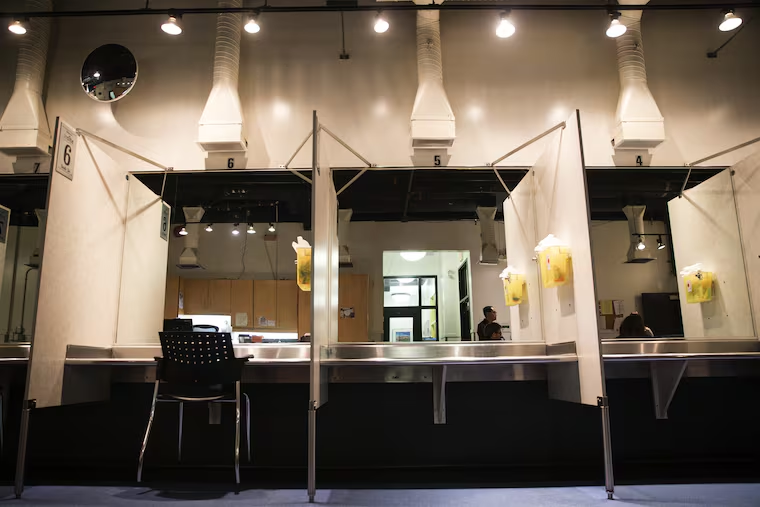First U.S. supervised injection site? Scientists say it’s operating secretly, somewhere.
The clandestine site has been quietly operating in an undisclosed location since 2014.

Even as advocates in U.S. cities including Philadelphia have struggled to open supervised injection sites to help stop fatal overdoses, a clandestine site has been operating somewhere in the country since 2014.
Researchers studying the site, where people can inject drugs and be revived by medical staff if they overdose, recently released data collected there since its opening. Clients can visit the site only by invitation.
The site supervised 9,085 injections by 540 people between September 2014 and April 2019, and staffers there reversed 26 overdoses.
That might seem like a low number, said Barrot Lambdin, a senior epidemiologist at RTI International, the North Carolina-based research nonprofit that conducted the study. But it represents a worrying spike in overdoses: In 2015, staffers at the site reported only one overdose for every 1,000 injections. By the first half of this year, they were reporting one overdose for every 167 injections.
It’s a trend mirrored on Philadelphia’s streets, as lethal fentanyl has infiltrated virtually all of the city’s heroin supply.
“If you can imagine this is reflective of what’s occurring in the community, that is a massive overdose rate that would take a massive effort to respond to on a community basis,” Lambdin said.
Yet unlike the local situation, deaths in this supervised injection site do not follow overdoses.
“Despite the rapid rise in overdoses, the death rate [in the site] has remained at zero. We’re seeing results similar to sites in other locations” outside the United States, Lambdin said.
Supervised injection sites have existed in Canada and Europe for decades, and no one has ever died in one. But efforts to open a site in the U.S. only began in earnest in the last few years. Cities that have decided to sanction them have faced legislative backlash or delayed their efforts. Philadelphia advocates looking to open a site were sued by the U.S. Attorney’s Office earlier this year.
The suit asks a judge to rule that the sites were illegal based on the “crack-house statute,” a federal law that makes knowingly opening or maintaining any place for the purpose of manufacturing, distributing, or using controlled substances a felony punishable by up to 20 years in prison. Advocates responded, in a countersuit, that the sites are a legitimate public health measure in a city where more than 3,000 people have died of overdoses in three years.
The clandestine site has been quietly operating for years. Lambdin’s data, presented at a harm-reduction conference in Portugal last month and funded by the progressive philanthropy LLC Arnold Ventures, didn’t closely examine the site’s effect on the community in which it is located.
“There have been no reports of negative consequences from the site, no acute complications, no violence," he said. “It’s largely been able to operate without being noticed.”
According to prior research on the site, published in 2017, a social service agency in an “urban area” of the U.S. operates the site.
“The agency provides other social services that are open to the general public,” wrote researchers Alex Kral, also an RTI epidemiologist, and Peter Davidson, an assistant professor at the University of San Diego. “Once a person comes to the agency a few times and appears to need supervised injection services, they are invited to use the supervised injection room.”
About 60 people at a given time had “active privileges” at the site, they wrote.
The site’s layout is similar to supervised injection sites elsewhere in the world: There are two large rooms, one for injection and one where clients can rest afterward, Lambdin said. Clients inject drugs (which they have brought with them) at six stainless-steel stations with tables, clean needles, and mirrors for accurate injections — a botched injection or a missed vein can result in life-threatening infected abscesses. A staffer inside the first room watches and dispenses the overdose-reversing drug naloxone if necessary.
The site has not contributed to the spread of any infectious diseases, Lambdin said, and about 90 percent of clients reported that they would have injected in public had the site not been available to them. He said the site had prevented an estimated 8,400 public injections.
The 2017 study included the results of an anonymous survey that staffers presented to clients every time they injected, between 2014 and 2016. The overwhelming majority of clients at the site were white men, and nearly everyone using the site was homeless.
Heroin was the most frequently used drug at the site, but users also brought in opioid pills, methamphetamine, cocaine, and crack — though ventilation concerns led the site to ban smoking inside. Thirteen percent of injections were a mix of drugs, like a “speedball,” a combination of heroin and cocaine.
Six percent of clients reported having overdosed in the previous month outside the site. Also, 25 percent said they had witnessed an overdose in the same time period.
Lambdin said that his research team’s data suggest American cities should consider the sites as a tool to prevent overdoses.
“Given the constant concern about police, or some sort of interdiction by law enforcement, these are, to me, very promising results given the intense and difficult environment the site is operating in,” he said. “I would advocate as a scientist that we be willing to try it, and study it rigorously. I hope we find the courage to do it.”